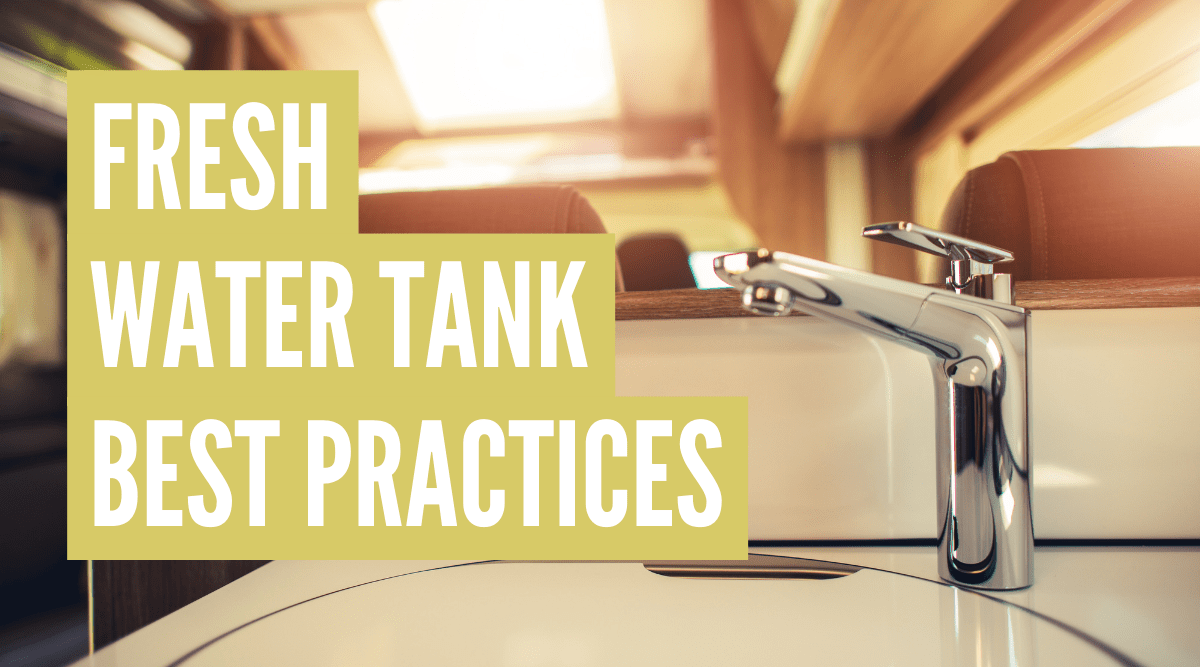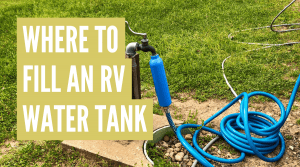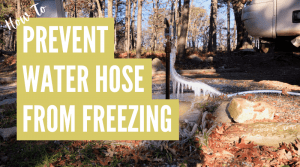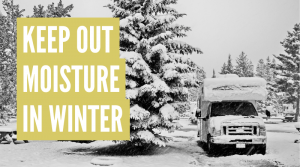Camper FAQs is reader-supported. Buying through links on our site may earn us an affiliate commission. As an Amazon Associate I earn from qualifying purchases.
RVs are designed to bring the comforts of home with you on the road, with one of the main comforts being fresh water at your disposal.
However, some care and general know-how are needed to keep your water supply and the system that holds it fresh.
So, let’s learn how long you can keep fresh water in an RV tank, plus tips to keep it fresh for as long as possible!
How Does an RV Water Tank Work?

First, let’s quickly cover how a fresh water tank in an RV works. If you’re already intimately familiar with your RVs water system, you can skip this section.
The fresh water tank is essentially a fiberglass (or plastic) storage tank that sits in the underbelly of your RV. It holds your fresh water supply for drinking, cooking, cleaning, and so on.
Once you flush a toilet or open a faucet, for example, a pump draws water from the tank, and the water flows through the pressure release valve and into the aforementioned toilet or sink.
Two tanks dispose of the water on the other end – a grey and black tank. A grey water tank collects the water from the sink or the shower. The black water tank takes in the wastewater from a flushed toilet.
Pretty simple, right?
Why Can’t I Store Water in an RV Forever?
Getting clean water from a reliable source and sanitizing the tank does not mean it will stay fresh forever. Eventually, the water will become contaminated and will continue to degrade until it’s no longer safe to use.
The main causes of water contamination are:
- Mold
- Parasites
- Bacteria
And these water contaminants can potentially enter your fresh water supply in a multitude of ways.
How Contaminants Enter Your Fresh Water System
Filling Hose
Your typical garden hose can have lead fittings and non-safe liners on the inside and typically aren’t labeled as “safe for drinking.”
When you fill your RV water tank with freshwater, you must use a non-toxic hose designed for drinking water. And be sure to only use this hose for the sole purpose of filling your water tank.

Camco 25ft Premium RV Drinking Water Hose
Price:Clicking this link to make a purchase may earn us a commission at no additional cost to you.
Poor Water Source
When you’re out on the road, you will find yourself filling up your fresh water tank with water from various sources – RV parks, gas stations, wells, etc.
In other words, you don’t always know whether the water is safe or not. This is why using a water filtration system when filling your tank is important. This will remove harmful bacteria and other contaminants before reaching your tanks.

Camco TastePure RV Water Filter
Price:Clicking this link to make a purchase may earn us a commission at no additional cost to you.
Poor Winterization & De-Winterization
If you didn’t properly winterize your camper, you might have left excess water and moisture in your tanks and water lines, which will be a breeding ground for mold and bacteria as it just sits there for months. And remember, de-winterizing your camper correctly is just as important for safe and clean water.
Not Sanitizing The Water System
One of the most important steps to ensure clean and fresh water is to sanitize the water system. Not properly cleaning your water tank and lines will create the perfect environment for contaminants to grow.
So, whenever you take your RV out of storage or if you start to notice a foul smell or bad taste coming from your water, be sure to properly sanitize your water system.
How Long to Keep Fresh Water in Your Tank Before Changing
As a general rule, you should only keep water in the tank for two weeks before changing it.
However, there is a multitude of factors that can affect how long your water will stay fresh. For example, the source you got your water from, how clean your water tank was before filling it, if you filtered your water before filling your tank, and so on.
Also, keep in mind how you use your water is a factor. If you are using it for drinking and cooking, then the two-week rule is a good guideline. However, if you are just using it to shower, for the toilet, or other non-consumption purposes, then you can extend that out by another few weeks.
Signs That The Water Is No Longer Fresh
The water in your tank should stay fresh for at least two weeks if you follow the advice above. However, if you’re starting to question the freshness of your water supply, then be on the lookout for the following:
- Foul Odor Or Smell: The smell will be strong enough for you to detect that it’s off, and the water will also have a strange flavor, no longer tasting as fresh as it was before.
- Change In Water Color: This change will usually appear as orange or brown tinges. When the water is no longer fresh, it’s also possible to start clogging the water lines.
- Sick Feeling: If you and/or other campers start to feel nausea, stomach cramps, diarrhea, or other symptoms, it won’t hurt to flush your water system. It may even be time to sanitize the system if it’s been a while.
You can test the water, as well, for harmful disease-causing bacteria like E Coli and salmonella periodically to ensure it’s safe for consumption.

Coliform Bacteria Test Kit for Drinking Water
Price:Clicking this link to make a purchase may earn us a commission at no additional cost to you.
How to Keep Water Fresh in Your RV Tank
To keep the water in your tank fresh for as long as possible, there are a few things you need to routinely do. Skipping any of these can cause bacteria and other contaminants to grow, so make them a part of your regular maintenance routine.
Flush the Water System
As we mentioned, your water can stay fresh in a tank for about fourteen days (and up to a month for non-consumption use).
After that, it’s a good idea to completely flush the water out of the tank and lines. You essentially want to get rid of the water before any bacteria or contaminants have a chance to grow.
This will help keep your next tank of water fresher longer by reducing the number of contaminants that could potentially start growing in your tank.
You can flush the tank easily by running the water in the shower or putting a secondary hose in the toilet. At the same time, you should also clean out the black and gray tanks. You can do that at an RV waste dump station and get clean water for your tank. Check out our post on where to fill an RV fresh water tank if your dump station does not offer fresh water.
Sanitize the Tank
Flushing the tank and replacing the water regularly will help, but you should sanitize the system for optimal cleanliness when taking your RV out of storage (or notice a foul odor). If you don’t maintain it regularly, the smallest bacterium can grow and multiply.
We cover this process extensively in our guide on how to sanitize an RV freshwater tank and lines, so check it out. It also has some very important tips on what NOT to do when sanitizing your tank.
To quickly summarize the process, the easiest way to sanitize your tank is with household bleach and water. Mix the bleach into the tank using a ratio of a quarter cup of bleach for every 15 gallons of water.
Important: Do not pour bleach directly into the empty water tank. Mix the bleach with water first, dump it into the tank, then fill it the rest of the way full with water.
Next, turn on the faucets until you smell bleach coming out of them, then close them. This fills the water lines with the bleach and water mixture.
Now, let the mixture sit in the tank and lines for 12 hours to effectively sanitize it.
Finally, drain the fresh water system and refill it with potable water. You may have to flush the system a few times to ensure the bleach is completely gone.
Here’s a quick video on properly sanitizing your fresh water system.
If you don’t like the idea of using bleach or find that bleach isn’t working very well, use Camco’s TastePURE Spring Fresh Water System Cleaner and Deodorizer.

Camco TastePURE Spring Fresh Water System Cleaner and Deodorizer
Price:Clicking this link to make a purchase may earn us a commission at no additional cost to you.
Use the Correct Hose
Using your typical garden hose to fill your fresh water tank is NOT considered “best practice” since it may have lead fittings, non-safe liners on the inside, and typically aren’t labeled as “safe for drinking.” Even if your source supplies fresh water, the garden hose could potentially contaminate the tank.
Instead, you should use a dedicated filler hose designed for RV use. Manufacturers designed these to fit tightly into the valve, lowering the risk of the hose carrying contaminants into your tank.
Plus, they don’t use any lead in the construction and have a chemical-free lining.

Camco 25ft Premium RV Drinking Water Hose
Price:Clicking this link to make a purchase may earn us a commission at no additional cost to you.
Use a Water Filter
A water filter will help ensure that the water you add to your tank is clean and free of bacteria and other contaminants. Plus, it reduces chlorine and bad odors in your water. Your filtered water will have a longer shelf-life and taste better too!

Camco TastePure RV Water Filter
Price:Clicking this link to make a purchase may earn us a commission at no additional cost to you.







Write a comment